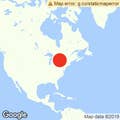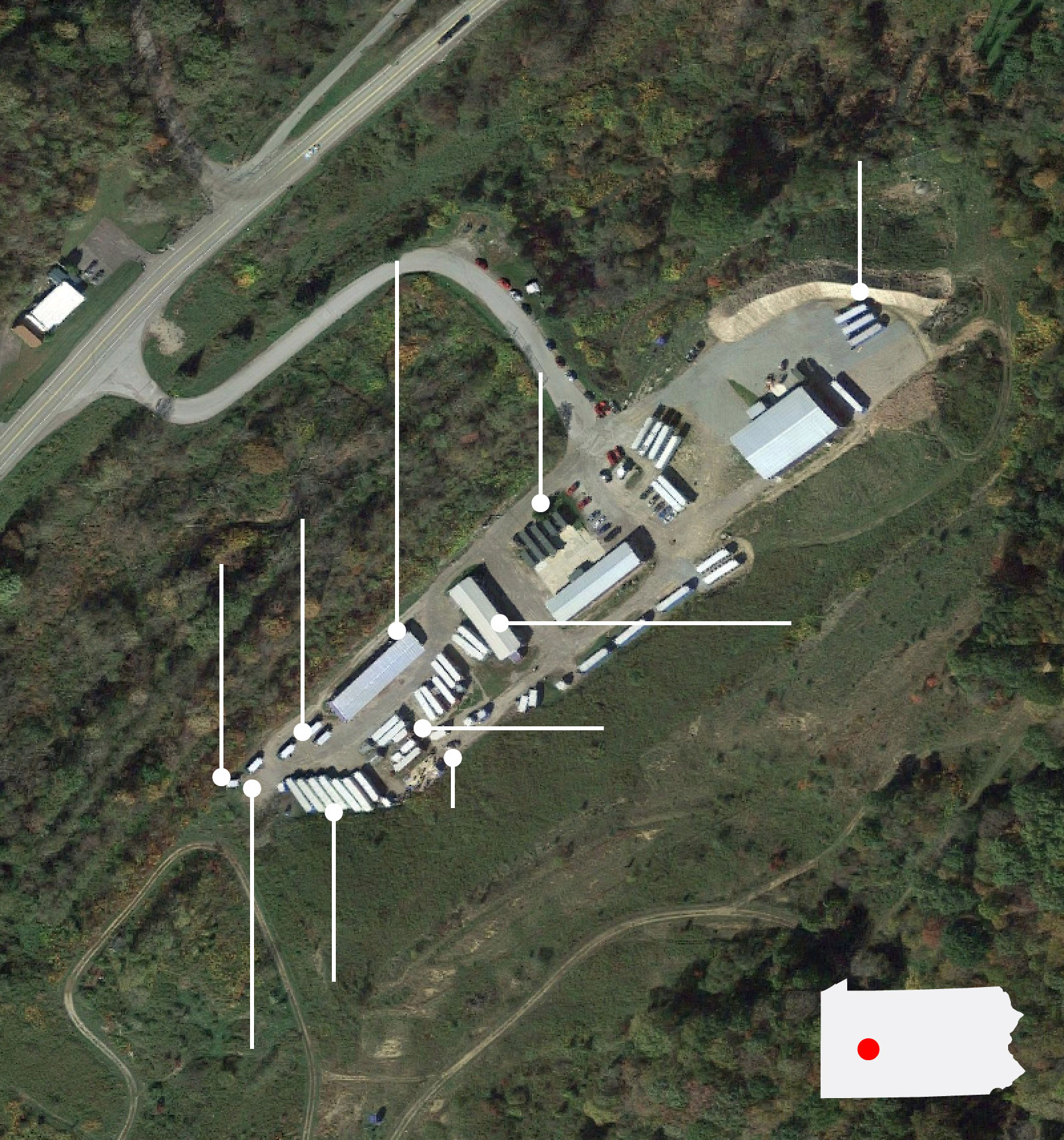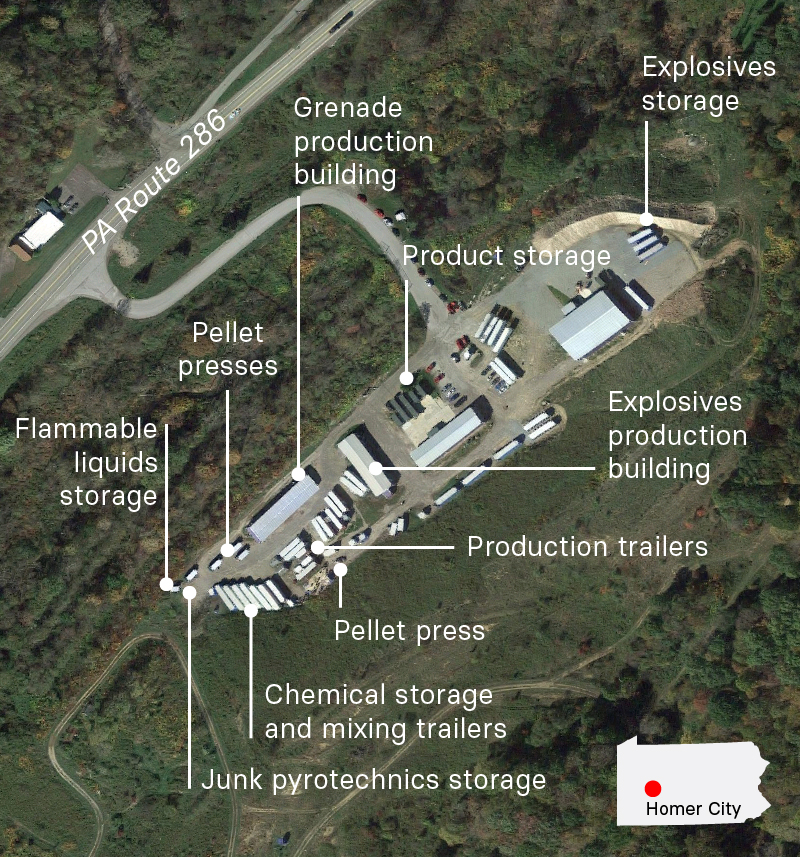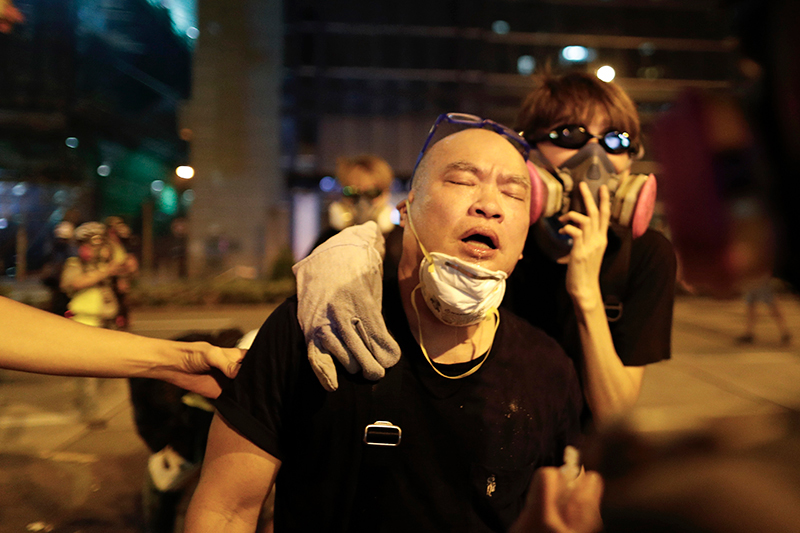
HOMER CITY, Pennsylvania — There’s no sign for Nonlethal Technologies when you drive past the pair of faded yellow gates on the side of the highway in western Pennsylvania.
Despite its name, there isn’t much sign of any technology once you get inside the gates, either — there are just a few rows of worn-looking shipping containers clustered together. But the little-known company is a major exporter of tear gas and other crowd-control equipment and has sold supplies to a number of countries, including repressive regimes, for years.
Most recently, hundreds of the company’s tear gas canisters have ended up on the streets of Hong Kong, where police have used them to crack down on pro-democracy protests that have rocked the city for more than three months. The demonstrations have shifted from large-scale marches that have brought as many as 2 million people to the streets to standoffs between police and protesters that often look more like guerilla warfare.
The trail of tear gas sailing through the air has become a familiar sight in Hong Kong as police launch round after round of these projectiles into the crowds of protesters. The acrid smell of tear gas is unmistakable — it fills your throat and nose and burns your eyes and skin, unless you wear a respirator. It can make you cough until you vomit.
By early August, 1,800 rounds of tear gas had been fired at protesters, according to the police — including 800 in a single day. Some come in the form of projectiles, which are launched from firearms, while others are more like grenades, and are thrown by hand. The numbers have only grown since then. The indiscriminate use of tear gas by police has been criticized by the UN Commissioner on Human Rights and Amnesty International, including for firing tear gas into subway stations, outside of a nursing home, and sometimes directly at individual protesters.
BuzzFeed News traveled nearly 8,000 miles from Hong Kong to Homer City, Pennsylvania, to learn more about the crowd-control equipment being shipped overseas.
Nonlethal Technologies is run by a father–son duo whose family has been in the tear gas business for at least three generations. While the pair control much of the sales and operations, BuzzFeed News spoke with a half dozen former employees — most of whom had each spent at least a decade working at the factory. A BuzzFeed News investigation based on a review of federal inspection records, court documents, and interviews with former employees found the company relies on American workers who are paid low wages to assemble products with hazardous materials and few safety measures to protect them.
Employees described aging equipment that caught fire and injuries and severe irritation caused by working long hours with chemicals. After one of its buildings burned down, the company declined to rebuild the facility, instead shifting more of the production into shipping containers. The company has been fined multiple times for safety violations by the Department of Labor; the owner himself severely burned his hands in a fire while handling hazardous chemicals. Yet while its American workers are paid very little to work in potentially dangerous conditions, its shipments continue — largely to foreign governments who reap the benefits of its products, employees said, including Turkey, Bahrain, and Egypt during the height of the Arab Spring.
“Your skin burns all day long. You’re outside in a full suit and gas mask but it still burns,” said Mike Dawson, who worked at Nonlethal Technologies for 15 years and became a supervisor. “You could never get used to it.”
One of the owners of Nonlethal Technologies answered questions briefly outside the factory before asking BuzzFeed News to leave the premises, and did not respond to more in-depth emailed questions.
The layout of Nonlethal Technologies’ factory, according to former workers.
Shifts at Nonlethal Technologies begin at 6:30 a.m. and stretch until 5 p.m. The starting pay is $9.50 an hour, barely up from $8 an hour when the factory opened nearly 20 years ago, said workers. It’s hard, repetitive work, and lots of people don’t last long in the job.
There are a few buildings on the site, including for storage and assembly, but much of the work preparing tear gas is done in large, metal shipping containers with the doors open. Workers carry the chemicals among the containers for each step of the process, so they’re largely working outside.
Most of the time staff are required to wear a protective suit, gloves, and a full-face gas mask. It’s not pleasant working in the cold of the winter, but in the summer, all the gear and chemicals become even more oppressive, said employees.
“The tear gas sticks to your sweat. And there’s no shade, there’s no ventilation,” said Jen Livengood, who worked at the facility for more than a decade until last year. “Sweat is rolling off of you and you do get rashes.”
Employees who spent years working at the factory told BuzzFeed News they stayed for the weekly paychecks, even if they weren’t large. With only around 30 employees, the company’s sales were estimated at $8 million a year in 2017, according to Visiongain, a UK-based market research firm.
There aren’t a lot of job opportunities in Indiana County, where the factory is based. Lots of people work in manufacturing or retail or health care, county data shows, and the per capita income is 30% lower than the rest of the state. In 2016, two-thirds of the county voted for Trump.
“There’s a lot of low-class impoverished people around here,” said one former longtime worker who got the job after seeing a sign outside the factory and was soon hired.
The most common type of tear gas used today — and the one that’s filled the streets of Hong Kong — is known as CS, or chlorobenzalmalononitrile. The Chemical Weapons Convention bans the use of tear gas in war but categorizes riot-control agents like CS separately from other chemical weapons, allowing police to use it to disperse crowds.
CS is not in fact a gas — at Nonlethal Technologies, the chemical base is mixed with hot water until it forms a white crystal, which is laid out on tables in one of the shipping containers until it dries.
Once it’s dry, workers carry the CS, which first takes on a Play-Doh–type consistency, to the next shipping container using buckets. There, it’s combined with a pyrotechnic mix that includes powdered sugar and several other chemicals, like magnesium oxide and potassium chlorate. Sugar is flammable and provides a cheap accelerant, while potassium chlorate is an explosive.
The final mixture is shaken up in large bags until it becomes a fine powder. That’s poured into a large pellet press that compounds the chemical mix into small, concentrated tablets that are later loaded into canisters or projectiles.
Even with the protective gear, flakes of the chemicals get everywhere.
“It’s all powder until it’s set off. But it’s very strong and concentrated,” said Emily Panczak, who worked in production there until earlier this year. Several other former workers said the flakes could get in their masks or in the suit, irritating their skin.
“The whole place has CS all over, it can’t be helped,” Panczak added. “It all sucked, but it was a steady job.”
Once the chemical production process is finished, workers assemble the tear gas projectiles by hand too, loading the primer — the part that ignites the explosive — and the tear gas pellet and sealing the projectile. Even the bright blue lettering of “Nonlethal Technologies” on the outside of the silver canisters is screen-printed by hand.
When Bob Mahnke got a job at Nonlethal Technologies, he spent a few weeks just working on loading the primers into the projectiles. But after a day of loading the tear gas pellets into the canisters, he had a bad reaction to the chemicals, Mahnke said.
Even working in protective gear, the chemicals severely affected him, he said. Mahnke can’t quite recall how it happened — the air had blown some material under his gas mask, or maybe he’d wiped his brow — but by the time he went on break, his whole face had started to redden and swell.
“My face was so swollen that my left eye was completely shut. And then my right one completely shut. I looked like a totally different person,” he recalled. He had to quit the job.
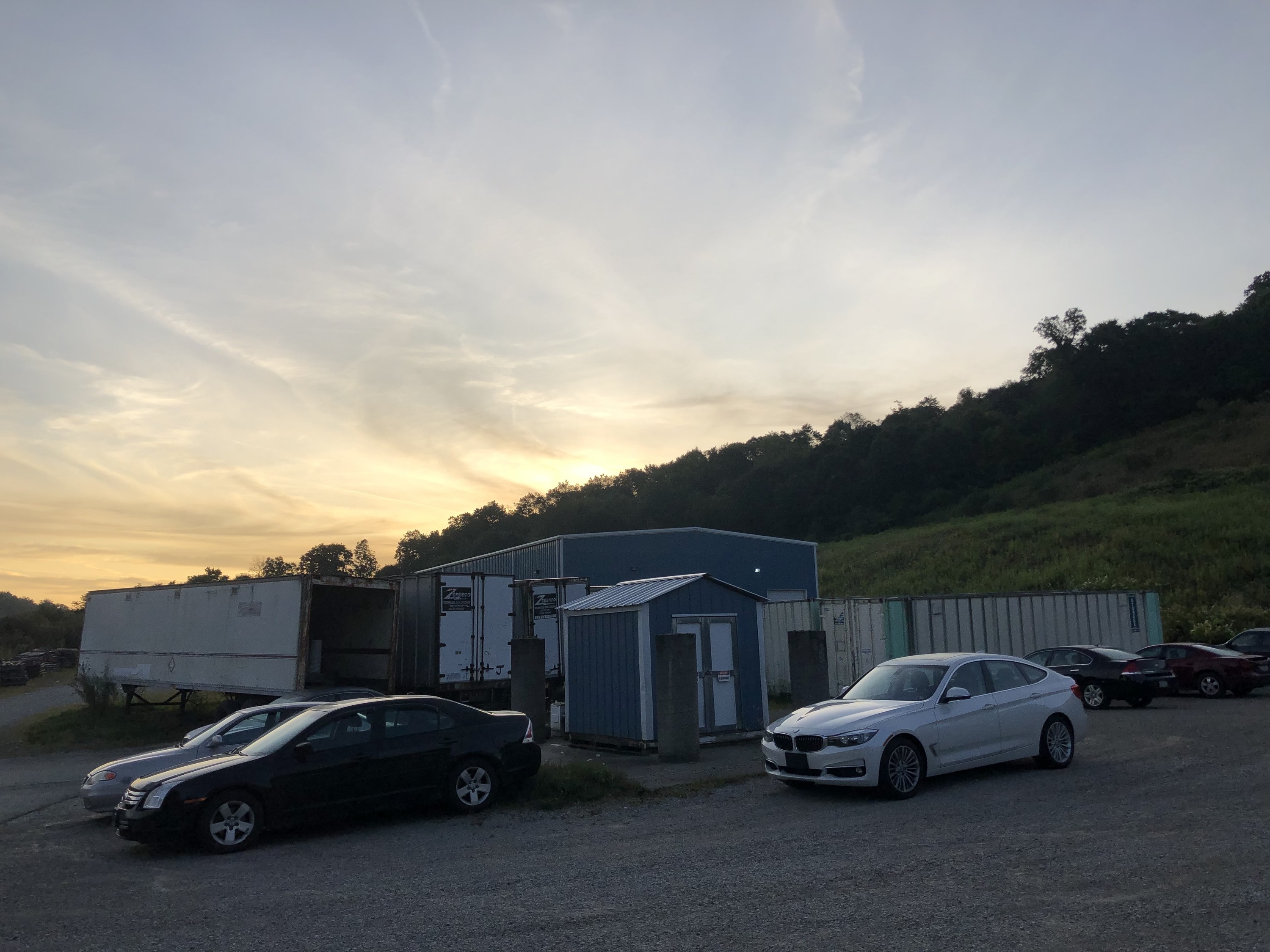
Nonlethal Technologies is owned by the Oberdick family, which has been in the tear gas industry for three generations. In the 1930s, Gus Oberdick started out as the secretary to the president of Federal Laboratories — America’s oldest tear gas factory. Back then, the company made its tear gas in Pittsburgh, selling domestically to authorities wanting to stop bank robbers or to break up labor riots but also to foreign governments, like Cuba and Honduras.
Gus Oberdick’s son Jim later founded Nonlethal Technologies with his own son, Scott — both men also worked as chemists at Federal Laboratories, according to company sales materials and state business filings.
Nonlethal Technologies started off modestly in 2000 after it acquired a majority stake in a nearby tear gas company. It was first just a handful of employees, recalled Shawna McCutcheon, who worked in human resources for more than a decade until 2017.
By the end of 2002, the company had moved its production facility to Homer City and reached around $250,000 in sales for the year, court records show. Early orders came in for a couple thousand pieces at a time, said Mike Dawson, who was the company’s first employee. But things took off after 2010, he said — right as the Arab Spring was causing turmoil in the Middle East. “We started getting huge orders for 300,000 pieces at a time,” said Dawson.
Egypt and Turkey and Bahrain all placed orders, he said. Sales reps came with translators to inspect and test the product, confirmed multiple employees.
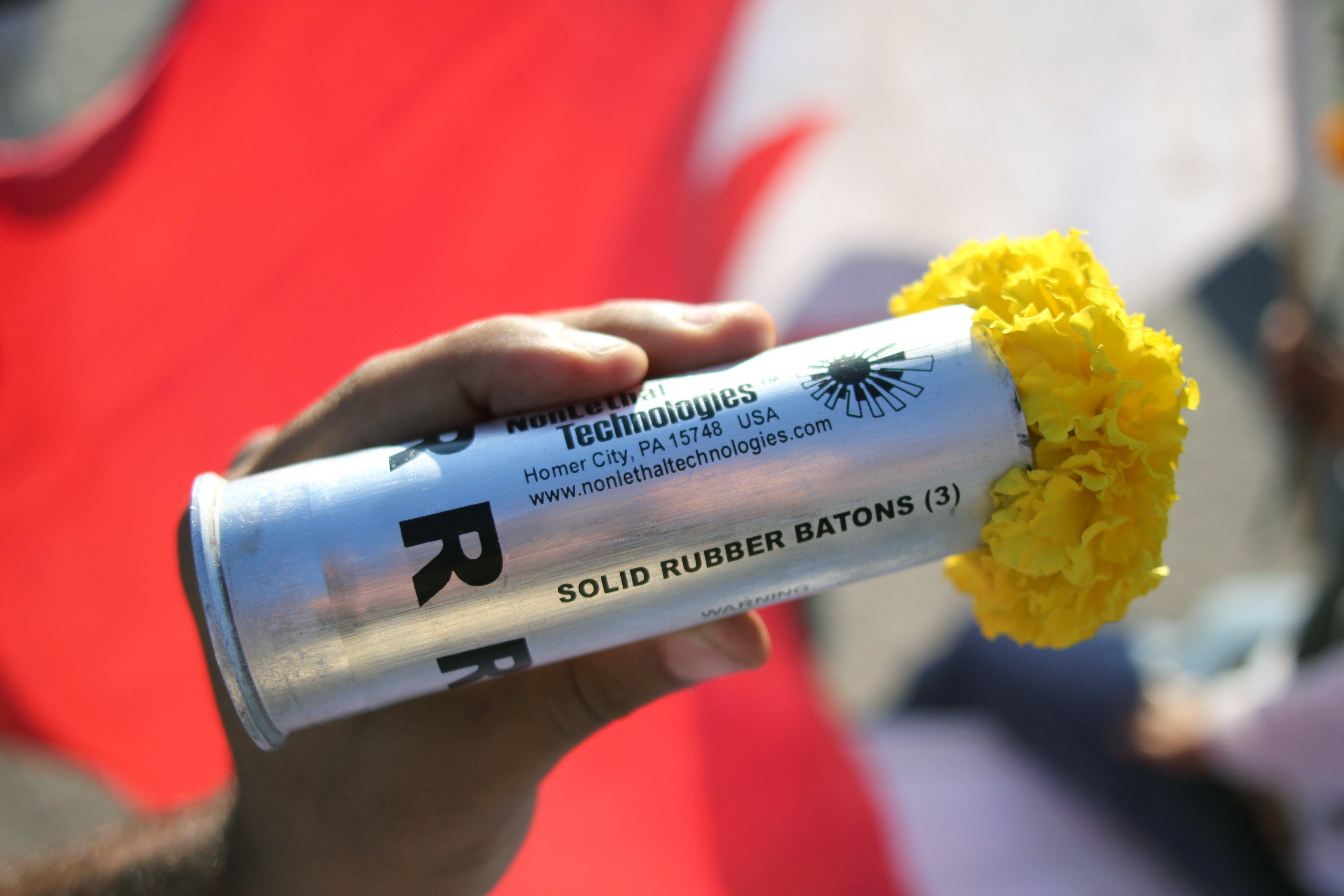
Nonlethal Technologies’ sales materials say that its testing procedures ensure “the highest reliability and performance of our end products and strict conformity to our printed specifications.”
But employees said the testing involved little more than using a stopwatch to check how long it took for a product to ignite or emit smoke in one of the storage containers.
Sometimes the countries it sold to made requests to change formulations of the products — like a faster-burning pellet or a longer delay on the fuse, said several employees who worked directly on the orders. “Turkey was always a pain in the ass. Always huge orders made to spec,” said Livengood.
As Nonlethal Technologies started aggressively increasing its operations, it was also relying on secondhand pellet presses and then repairing the equipment and replacing parts, said employees.
All the time, it was relying on low-skilled workers who were paid little. Some smoked pot on break, said multiple workers, but there was no employee drug testing. “I loved the people I worked with. But they're making low wages so you're not getting the cream of the crop,” said Livengood, who became a supervisor at the factory. “I was always afraid every day of something that could go wrong.”
In summer 2012, one of the buildings at the factory caught fire. The head of human resources, McCutcheon, told a local news outlet at the time that she believed it was due to one of the pellet-pressing machines catching on fire. Dawson, who told BuzzFeed News that he was nearby, said the fire was so intense he watched the flames shoot straight through the roof, engulfing the building within minutes. Many of the chemicals on the premises can’t simply be extinguished with water, and local news footage from the incident shows plumes of black smoke as firefighters from a half dozen fire departments work to put out the flames. The fire took down the whole building.
Fires also broke out at the factory in 2004 and 2009, according to local news reports.
Shortly after the 2012 fire, the Occupational Safety and Health Administration, or OSHA, issued four violations, including for mismanagement of highly hazardous chemicals, and fined the company more than $12,000.
When asked outside his office at Nonlethal Technologies about the OSHA violations, Oberdick said “it’s pretty normal for manufacturing.” Oberdick then pulled out his phone and threatened to call the police if BuzzFeed News did not leave the premises.
Rather than rebuilding after the fire, Oberdick moved more of the operations into shipping containers. The metal containers at least helped contain any fires, said former employees. “If the machine caught on fire, we would just close the door to the shipping container and wait for it to burn out,” said Livengood.
After any such fire, workers would wait for the chemicals to be incinerated, and then sweep the ashes out of the storage container and refill the pellet presses, said employees. “A lot of fires were unreported,” said Dawson.
In addition to tear gas, the company recently started getting huge orders for “flash bangs” — grenades that explode into a burst of sound and light and smoke. The chemicals in that mixture — a combination of aluminum powder and potassium perchlorate — are volatile.
Employees said they wore bracelets clipped onto copper wires that ran into the ground in an effort to stop the buildup of static electricity, which could set the powders off and risk causing a fire. They also wore gloves and eye protection. The assembly of the flash bangs, which became a popular product, was also done by hand.
“My process was I’d fold a notecard in half. I would mix up a batch of flash powder, put it into the notecard and brush it into the grenade body itself,” said a former worker who worked in production.
“You could have 16 grams of a really explosive material just right in the palm of your hand,” added Dawson.
The processes that workers described raised the concern of safety experts. “That doesn’t sound like a very safe process to me,” said Kenneth Brown, a consultant on chemical safety standards, told BuzzFeed News. “Things like this are usually automated. That’s what robots are for,” he added.
Scott Oberdick himself was in a storage container helping make the flash bangs a few years ago when his hands caught fire, several employees said. “I saw him come out of the trailer, holding his hands up in gloves and they were just melting off,” said Dawson.
Oberdick admitted he burned his hands in a fire when asked about the incident, but did not address any details.
“There were really no safety practices when I was there,” said Dawson, who spent 15 years working at the factory. More recently, OSHA cited Nonlethal Technologies again for mishandling hazardous chemicals in April 2018 and issued the company a fine of more than $6,000.
Still, the big orders have continued.
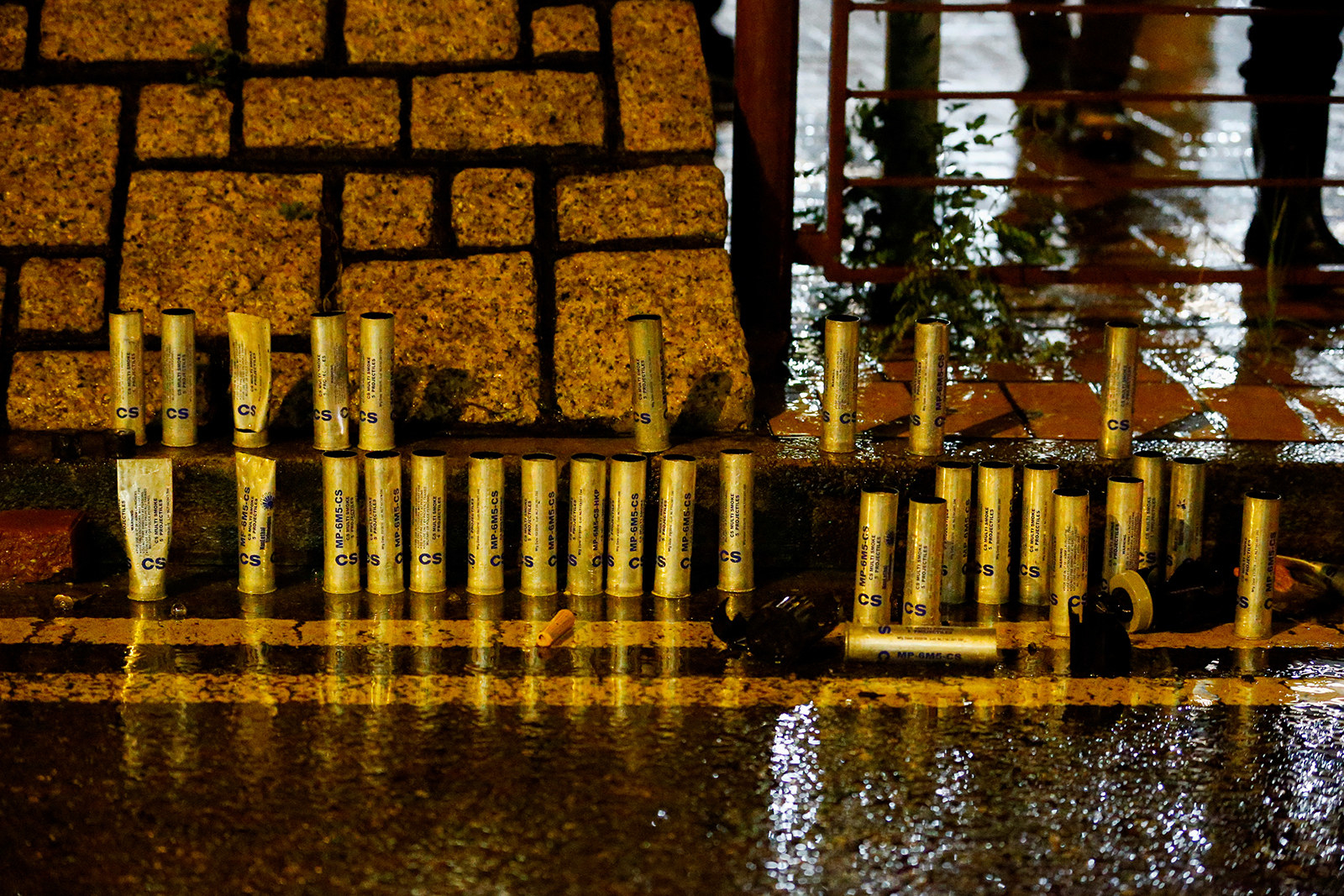
Canisters produced by Nonlethal Technologies have littered the streets of Hong Kong all summer. BuzzFeed News recently found one at a protest that was dated January 2019.
There aren’t many restrictions on US companies selling tear gas overseas, beyond applying for an export license from the Department of Commerce. Companies can apply for the licenses without having a specific contract or order in place, and a license can cover multiple shipments.
Federal regulations also outline that the government generally grants these licenses unless there’s evidence that a country may have violated international human rights standards.
The licenses themselves, however, are confidential, and it’s unclear when they were issued for companies like Nonlethal Technologies that have shipped to Hong Kong. Human rights advocates have called on the US government to stop the shipments altogether, citing the way Hong Kong police have used tear gas. In July, Amnesty International wrote a letter to the Commerce Department demanding it suspend shipments of all crowd-control equipment.
Others are concerned that licenses have recently been granted despite the increasingly heavy-handed approach of the police. “The question is whether the Department of Commerce approved any licenses since the unrest in Hong Kong started,” said Susan Waltz, a public policy professor at the University of Michigan and a former board member of Amnesty International.
And even though tear gas is widely used, its effects are not well understood, and the published studies declaring it a safe tool don’t stand up to modern toxicological standards, according to Sven-Eric Jordt, a professor at Duke University.
“I’m very concerned that we’re underestimating the toxicity, especially when it’s fired in these more dense cities like Cairo and Hong Kong,” he said.
Although there are guidelines — such as not firing tear gas indoors — it’s impossible to say how well enforced they are, said Jordt. “There’s no rules that these companies insist on once the products leave the US,” he said.
Joshua Wong, who led the 2014 pro-democracy protests in Hong Kong known as the Umbrella Movement, has repeatedly called for the US to stop sending crowd-control equipment. Last Friday, Wong was one of a number of activists and lawmakers arrested in Hong Kong as the city headed into its 13th weekend of protests. He is now out on bail.
These calls have been echoed by politicians in the US. Rep. Jim McGovern, a Democrat from Massachusetts, said he was planning on introducing legislation to suspend US sales of munitions and other crowd-control equipment to Hong Kong.
Due to the excessive use of force & lack of restraint by #HongKong authorities, I will soon introduce legislation to suspend U.S. sales of munitions, police & crowd control equipment to the #HongKong police. https://t.co/QnDWYZQka1
And in August, US legislators, including McGovern, wrote to the secretary of commerce, Wilbur Ross, and Secretary of State Mike Pompeo, calling for a ban on exports of tear gas from the US to Hong Kong.
“These steps are a necessary response to credible reports of excessive force being used by the Hong Kong police targeting individuals engaged in peaceful demonstrations against the Hong Kong Government’s proposed extradition bill and the fast-eroding space for political participation,” the letter read.
The administration has not commented on whether it will suspend sales of crowd-control equipment. ●

